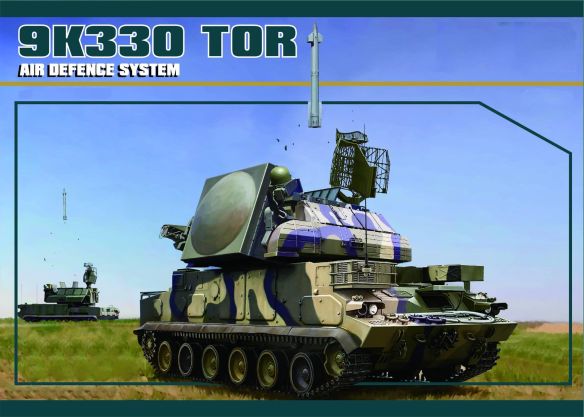9A331-1 combat vehicle
Intended for effective defense of troops, civilian and industrial facilities from current and future air attack weapons, primarily high-precision weapons, as well as from aircraft, helicopters, cruise missiles, guided aerial bombs and remotely piloted vehicles.
TOR-M1 air defense missile system which succeeded the OSA-AKM ADMC is one of the most advanced shortrange air defense systems. To the present day, TOR-M1 has no foreign analogues that could so effectively engage the cruise missiles, glide and guided bombs, small and actively maneuvering targets at the altitudes from 10 meters to 6 kilometers and at a range of 12 kilometers. The system is being in demand not only in the Russian army but also among many foreign customers. It is now in service with Greece, China, Iran and Egypt.
TOR-M1 is designed to defend the important administrative economic and military facilities, first echelons of the land forces and formations against the attacks of the antiradar and cruise missiles, remotely piloted vehicles, glide bombs, aircraft and helicopters, including of stealth technology.
The system incorporates the combat vehicle (CV) and the AD missile module (with the missiles in the container launcher), vehicles, maintenance and repair facilities and the electronic computer-aided operator’s trainer of the combat vehicle.
TOR-M1 basic element is the combat vehicle mounted on the cross-country self-propelled tracked chassis. It can detect the air targets independently on the move, determine their state identity and engage them at short halts. Unique design solutions implemented in TOR-M1, i.e. missile vertical launch scheme; ammunition up to eight missiles; capability of detecting up to 48 targets at a distance of up to 27 km; selection of up to 10 high threats and simultaneous engagement of two targets by two missiles; high level of automation; effective operation in the active and passive jamming environment, can reduce to a minimum the time to engage the surprise air targets.
All the radar, optical and computer equipment, missile ammunition and missile launch facilities, electrical power supply sources, survey control and life support equipment of the TOR-M1 crew are installed on one cross-country softskin tracked chassis that greatly improves mobility and endurance of the combat vehicle.
9A331-1 combat vehicle
The basic component of the system is a combat vehicle mounted on a cross-country tracked chassis of the intermediate weight category. The combat vehicle can detect aerial targets on the move and launch air defense missiles at two highest threat targets from a short halt. The combat vehicle comprises:
– self-propelled armored tracked chassis;
– three-dimensional target acquisition radar;
– digital computer;
– antenna stabilization system;
– ground-based IFF interrogator;
– target tracking phased-array radar;
– TV/optical sight;
– automatic launch equipment;
– coded telemetry and command radio communications system;
– navigation, survey and orientation equipment;
– primary power supply system;
– crew life-support equipment;
– auxiliary equipment.
9M334 air defense missile module (9M331 missile and 9Ya281 transport launch canister)
The missile is designed around a canard configuration. It is launched vertically by a powder catapult to a height of 15 – 20 m. It is then turned in the target direction, and its main solid-propellant rocket motor gets ignited.
The single-stage rocket motor has two operating modes. In the liftoff mode, the motor imparts the maximum speed of 850 m/s to the missile for 4 s of flight; in the cruise mode, lasting up to 12 s, the motor maintains this speed. Such a flight speed envelope ensures the required power-to-weight ratio, which enables the missile to cover a zone of up to 12 km in range and defeat targets flying at a speed of up to 700 m/s and g-loads of up to 10 g. The missile is maintenance-free and accommodated in a four-compartment transport launch canister.
Command/control assets
Organizationally, four combat vehicles of the Tor-M1 AD missile system enter into the complement of an air defense missile battery, which is the smallest tactical element. The combat vehicles are controlled by the 9S737-M Ranzhir unified battery command post. The Tor-M1 AD missile system is shipped by any type of transport, including aircraft. The manufacturers of the Tor-M1 system render a full package of maintenance services to keep the system in combat readiness and offer modernization packages that markedly expand the system’s combat capabilities.
There are several modifications of the Tor-M1 system, such as the TorM1T (wheeled chassis mounted system) and a stationary version.
Composition
The Tor-M1 ADMS includes combat, technical and auxiliary assets.
Typical combat assets include:
- up to four 9A331-1 CVs with two SAM modules on each;
- 9M334 missile modules with four 9M331 missiles in each;
- 9S737M battery command post.
Technical assets include:
- maintenance assets for the ADM system and its vehicles;
- missiles loading/unloading, storage and transportation facilities with rigging equipment;
- ADMS group set of spare parts, tools and accessories.
Auxiliary assets comprise 9F678 self-contained simulator for CV operators. Each CV is equipped with life-support equipment, navigation and mission recording means. The CV onboard equipment can be mounted on either tracked or wheeled chassis, or in container.
The Tor-M1 ADMS can be shipped by all transportation means, including aircraft.
Number of targets:
simultaneously detected 48
simultaneously tracked 10
Target detection range, km 27
Target engagement envelope, km: range 1.0 – 12.0 altitude 0.01 – 6.0 cross-range 6.0
Target speed, m/s 0 – 700
Minimum target ERA, m2 -0.1
Reaction time (from target detection to missile liftoff), sec 5 – 10
Number of missiles on combat vehicle 8
Aircraft kill probability 0.6 – 0.95
Maximum vehicle speed, km/h 65
Weight of combat vehicle, kg 37,000
Fuel endurance (including equipment operation for 2 h), km 500
